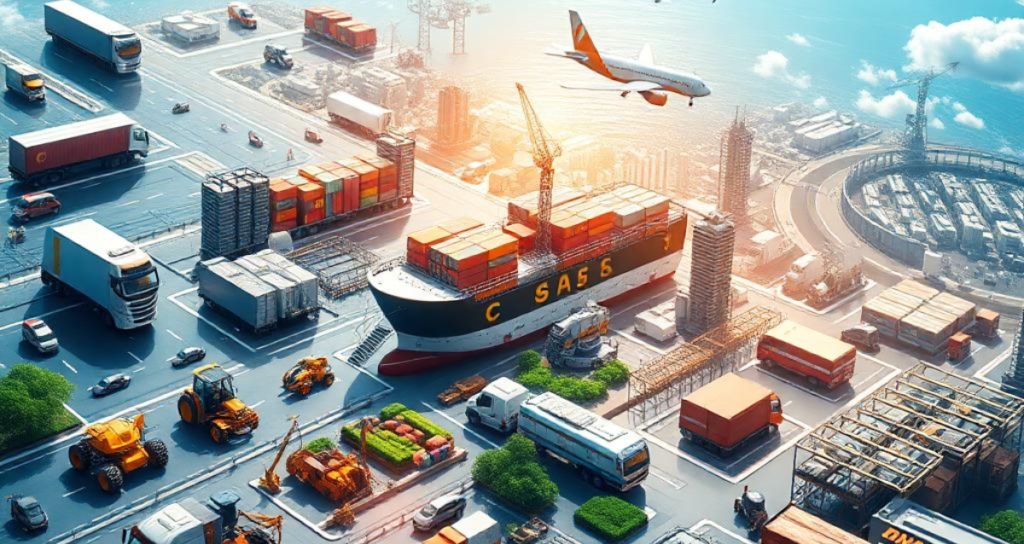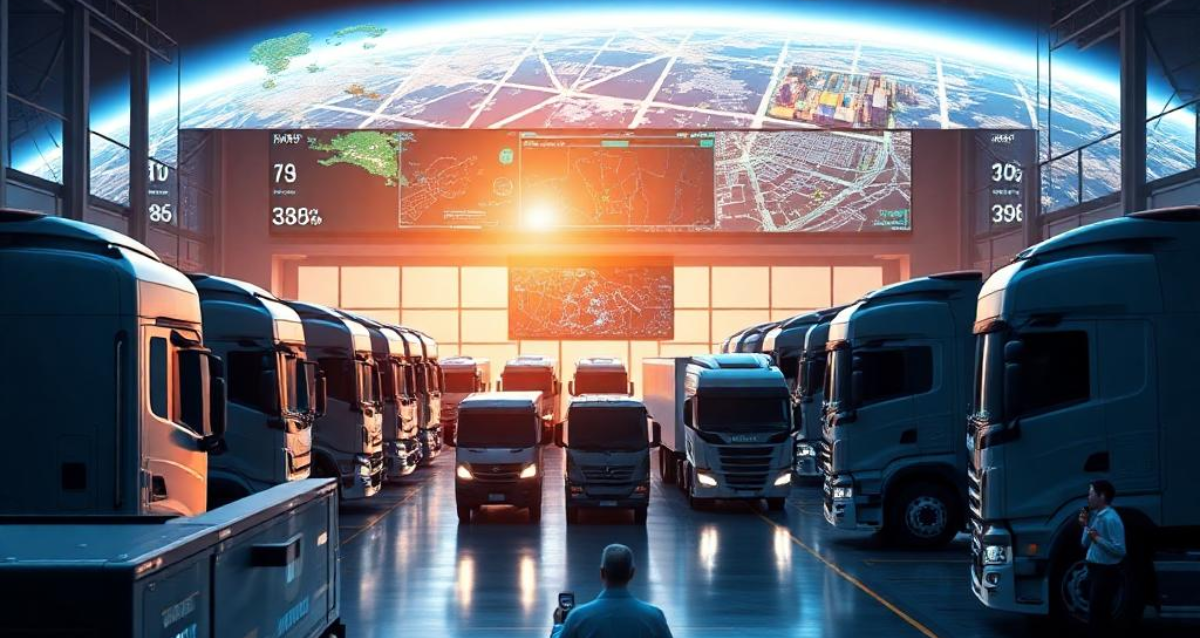2000s Technology Logistics GPS transformed with the general acceptance of GPS devices. Offering unheard-of efficiency, this invention changed supply chains, inventory tracking, and fleet management. The development of GPS technology in this century closed the distance between military and commercial uses, establishing new benchmarks for logistical activities worldwide.
GPS tracking tracks cars, assets, and shipments in real-time using GPS technology. This method sends precise and continuous location data derived from satellites to a central system for viewing and analysis. Originally kept for military use, GPS finally became available to the general public, drastically changing sectors, including logistics.
Table of Contents
What is GPS?
For air, sea, and land travel, the Global Positioning System (GPS) is a navigation system including satellites, receivers, and algorithms that coordinate position, velocity, and time data. Comprising 24 satellites in six Earth-centered orbital planes, each with four satellites orbiting 13,000 miles above Earth and flying at 8,700 mph, we may determine device height using a fourth satellite, which validates data and transports us into the third dimension.
GPS’s Historical Development
Humans have been navigating for thousands of years using the sun, moon, stars, and eventually the sextant. Space-age technology made the development of the 20th century possible: GPS.
- Early Origins of GPS
GPS originated as a military initiative in the 1960s by the U.S. Department of Defence. Initial usage was tracking and guidance, using satellites for accurate location information. In the 1980s, GPS technology grew and became an important part of military activities. - Development and Civilian Access
Late in the 1980s, civilian GPS technology became a reality. The selective availability capability, which restricted accuracy for non-military users and was terminated in 2000, helped to open the path for exact navigation in commercial sectors. With this change, GPS was included in fleet management and logistics.
Applications of 2000s Technology Logistics GPS
Today Technology Logistics in the 2000s GPS GPS transformed through real-time tracking and navigation features. These are some main applications of GPS in the logistics:
- Fleet Tracking: GPS systems fitted in cars let businesses instantly track their position, speed, and paths. This lowers fuel use, enhances driver safety, and helps to maximize delivery paths.
- Asset Tracking: GPS helps to avoid theft and enhance inventory control by tracking priceless goods such as construction tools, trailers, and containers.
- Warehouse Management: GPS-enabled devices track items inside warehouses, therefore enhancing accuracy and efficiency in inventory control.
- Supply Chain Visibility: GPS data may be included in supply chain management systems to give a real-time view of products in transit, enhancing decision-making and lowering delays.
- Inventory Control
GPS technologies help precisely track things in motion. Coupled with RFID technology, they improve supply chain visibility, reducing losses and delays. - Route Simplification
GPS systems help drivers select the fastest, most effective paths by analyzing traffic patterns and road conditions, lowering fuel consumption and delivery times.
Benefits of 2000s Technology Logistics GPS
The following are the main benefits of 2000s Technology Logistics GPS:
- Enhanced Efficiency: GPS lets one choose the best paths, therefore lowering fuel use and delivery times.
- Improved Customer Service: Real-time tracking gives precise ETAs, therefore improving customer service through accurate communication and satisfaction enhancement.
- Improved Safety: Tracking driver behavior and vehicle location advances more responsible driving.
- Reduced Costs: Significant cost reductions come from lower petrol expenses, less idle time, and less vehicle wear and tear.
- Better Decision Making: Real-time data and analytics enable educated choices on fleet management, route planning, and resource allocation.
- Improved Security: GPS monitoring guards against illegal vehicle usage and theft, therefore protecting priceless valuables.
Using the 2000s Technology Logistics GPS can help logistics businesses simplify their processes, enhance customer service, and develop a competitive edge in the market.
Disadvantages of GPS in Logistics
Although 2000s Technology Logistics GPS has several advantages for logistics, it is crucial to recognize certain possible drawbacks:
- Cost of Implementation: The initial investments in hardware (GPS trackers), software, and installation might be somewhat significant.
- Signal Interference: Tall structures, deliberate jamming, or weather can all disturb GPS signals, producing erroneous tracking or brief outages.
- Privacy Issues: Continuous monitoring of staff members might cause privacy issues and may lower staff morale.
- Dependency on Technology: Should the system fail or experience unanticipated disturbances, over-reliance on GPS may expose weaknesses.
- Data Security: Preventing illegal access or usage depends on ensuring the security of private location data.
Before using any tracking systems, logistics firms must carefully consider these possible adverse effects against the significant advantages of GPS technology.
Implementing 2000s Technology Logistics GPS
Effective GPS use in logistics calls for a multifarious strategy. The main actions involved are:
- Hardware Selection: Depending on vehicle type, tracking frequency, and required features, such as real-time tracking, geofencing, and fuel consumption monitoring, select suitable GPS tracking devices.
- Software Integration: Choose and put in use a strong fleet management system capable of efficiently gathering, processing, and evaluating GPS data.
- Installation and Deployment: Professionally install car GPS trackers and guarantee correct operation.
- Data Analysis and Reporting: Use the program to examine data, create reports on important indicators (e.g., driver behavior, fuel economy, delivery times), and point out areas for development.
- Driver Training: To overcome any privacy issues, teach drivers about the usage of GPS technology and its advantages.
- System Maintenance: To guarantee best performance and data accuracy, routinely maintain and update GPS devices and software.
- Integration with Existing Systems: Integrate GPS data with existing Enterprise Resource Planning (ERP) and Transportation Management Systems (TMS) for a seamless and efficient workflow.
Through meticulous preparation and implementation of these stages, logistics firms may mmaximizeGPS technology to improve operations, increase efficiency, and acquire a competitive edge.
GPS in Various Fields beyond Logistics

Beyond logistics, 2000s Technology Logistics GPS is used in a broad spectrum of disciplines and transforms navigation, tracking, and interaction with the surroundings.
1. Transportation:
• Trucking: GPS is an essential tool for truck drivers, as it offers real-time navigation, traffic updates, and route optimization. This reduces fuel consumption, minimizes delays, and improves motorist safety.
• Shipping: The precise monitoring of products in transit across oceans and continents is facilitated by the GPS tracking of cargo containers, ships, and even individual pallets. This enhances the visibility of the supply chain and reduces the likelihood of disruptions.
• Aviation: GPS is a critical component of aircraft navigation, particularly during departure, landing, and en-route flight. GPS-based systems improve flight safety and efficiency.
• Public Transportation: GPS allows for the real-time monitoring of buses, trains, and other public transport vehicles, thereby enhancing service reliability and providing passengers with precise arrival times.
2. Construction:
• Equipment Tracking: GPS transmitters are affixed to heavy machinery, such as cranes, bulldozers, and excavators, to monitor their location andutilizationn. This enhances project management, optimizes equipment allocation, and prevents larceny.
• Material Tracking: GPS technology can monitor the movement of construction materials, thereby minimizing delays and guaranteeing timely delivery to the site.
3. Agriculture:
• Precision Farming: GPS-guided tractors and other farm machinery enable precise planting, fertilization, and harvesting of crops, thereby optimizing resource utilization and yields.
• Livestock Tracking: GPS transmitters and sensors used to assess the health and location of livestock can enhance herd management and prevent livestock theft.
4. Emergency Services:
• Fire, Police, and Emergency Medical Services: GPS is essential for the rapid and efficient dispatch of emergency vehicles to the appropriate location. This has the potential to save lives in critical situations.
5. Retail:
• Inventory Management: The accuracy and efficacy of inventory can be enhanced by the ability of GPS-enabled devices to monitor the movement of products within warehouses and distribution centers.
• Delivery Services: GPS technology enables the real-time tracking of delivery vehicles, thereby improving customer satisfaction and providing customers with estimated delivery times.
Case Study: Orion and UPS
Global logistics behemoth UPS implemented ORION (Optimised Routing and Information On-road Navigation), a sophisticated route-optimizing technology. This system dynamically optimizes delivery paths using GPS data, real-time traffic information, weather conditions, and other elements.
- Impact: ORION has resulted in significant fuel savings, reduced emissions, and improved delivery efficiency for UPS.
“ORION is a testament to the power of technology to transform logistics. It demonstrates how GPS data when combined with advanced algorithms, can revolutionize how goods are moved around the world.” – Industry Expert.
Future of GPS in Logistics
Driven by continuous technical developments and changing industrial needs, GPS has great future possibilities in logistics. Like this:
- Integration using IoT: Combining GPS with other IoT devices, such as sensors and telematics, will enable more thorough data collection and analysis. For fleet management, sensors can track driver behavior, fuel economy, and vehicle condition, therefore offering insightful information.
- Autonomous vehicle GPS’s function: For autonomous vehicles in logistics, including delivery drones and self-driving trucks, GPS will be absolutely vital for navigation and operation.
- GPS and Blockchain Technology: Blockchain Technology with GPS Data Integration Improves supply chain operations’ security and openness by combining its use. Products may be tracked using blockchain technology to guarantee their authenticity, and the movement of commodities can be tracked.
- Artificial Intelligence (AI) and Machine Learning: Using historical GPS data, traffic patterns, and other elements, artificial intelligence (AI) and machine learning algorithms may forecast and maximize logistical operations. This can result in more effective route planning, better delivery schedules, and fewer expenses.
CONCLUSION
The adoption of GPS technology in logistics during the 2000s was a game-changer, reshaping industries worldwide. 2000s Technology Logistics GPS enabled real-time tracking, efficient route optimization, and enhanced customer satisfaction. Despite challenges like signal blockage, the advancements in IoT and AI have strengthened its applications. The 2000s Technology Logistics GPS continues to evolve, with blockchain integration ensuring security and transparency. Autonomous vehicles also rely heavily on 2000s Technology Logistics GPS, further cementing its role in innovation. As GPS technology progresses, the legacy of 2000s Technology Logistics GPS remains pivotal in driving efficiency and reliability across industries.
GPS helps various systems function smoothly. This positioning, navigation, and timing service is based on a constellation of at least 24 satellites, with additional reserves for operational readiness. Satellites circle the Earth twice daily at an altitude of approximately 20,200 km (12,550 miles), transmitting data managed by the U.S. Air Force to ensure global coverage and accuracy.
FAQ
1. What is the main advantage of GPS in logistics?
GPS’s real-time tracking, route optimization, and cost savings boost operational efficiency. In the 2000s, Technology Logistics GPS changed supply chain management for enterprises.
2. What challenges does GPS face in logistics?
GPS systems struggle with signal blocking, hacking, and overreliance on technology. Despite these issues, the 2000s Technology Logistics GPS developments provide a potent means to reduce such hazards.
3. Can GPS integrate with other technologies?
GPS works smoothly with IoT, AI, and blockchain, improving logistics and other applications. The 2000s Technology Logistics GPS provided the groundwork for more intelligent, more efficient operations.
4. How is GPS shaping the future of logistics?
GPS, AI, and IoT are enabling predictive analytics, autonomous cars, and supply chain visibility. The legacy of 2000s Technology Logistics GPS continues to influence modern advancements in the industry.

